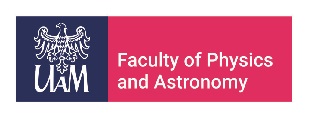
Dr hab. Anna Kowalewska -Kudłaszyk, prof. UAM
- Tel: +48 61 829 5166
- Loc: wing G, second floor, room 289
- Email: annakow@amu.edu.pl
Scientific degrees
Habilitation – 2016
PhD in Physics – 2000
Research interests
keywords: quantum optics, quantum engineering, quantum information
Publications
2025 |
|
| 7. | Karol Bartkiewicz, Grzegorz Chimczak, Anna Kowalewska-Kudłaszyk, Adam Miranowicz, Joanna K. Kalaga, Jan Peřina Jr., Wiesław Leoński Quantumness and its hierarchies in -symmetric down-conversion models Phys. Rev. A, pp. –, 2025. @article{9vty-ctf7, title = {Quantumness and its hierarchies in -symmetric down-conversion models}, author = {Karol Bartkiewicz and Grzegorz Chimczak and Anna Kowalewska-Kudłaszyk and Adam Miranowicz and Joanna K. Kalaga and Jan Peřina Jr. and Wiesław Leoński}, url = {https://link.aps.org/doi/10.1103/9vty-ctf7}, doi = {10.1103/9vty-ctf7}, year = {2025}, date = {2025-09-01}, journal = {Phys. Rev. A}, pages = {--}, publisher = {American Physical Society}, keywords = {}, pubstate = {published}, tppubtype = {article} } |
| 6. | Jan Peřina, Karol Bartkiewicz, Grzegorz Chimczak, Anna Kowalewska-Kudłaszyk, Adam Miranowicz, Joanna K Kalaga, Wiesław Leoński Quantumness and its hierarchies in PT-symmetric down-conversion models Physical Review A, 112 (4), 2025, ISSN: 2469-9934. @article{Peina2025, title = {Quantumness and its hierarchies in PT-symmetric down-conversion models}, author = {Jan Peřina and Karol Bartkiewicz and Grzegorz Chimczak and Anna Kowalewska-Kudłaszyk and Adam Miranowicz and Joanna K Kalaga and Wiesław Leoński}, url = {http://dx.doi.org/10.1103/9vty-ctf7}, doi = {10.1103/9vty-ctf7}, issn = {2469-9934}, year = {2025}, date = {2025-01-01}, journal = {Physical Review A}, volume = {112}, number = {4}, publisher = {American Physical Society (APS)}, keywords = {}, pubstate = {published}, tppubtype = {article} } |
2024 |
|
| 5. | Joanna K Kalaga, Anna Kowalewska-Kudłaszyk, Wiesław Leoński, Jan Peřina Legget-Garg inequality for a two-mode entangled bosonic system Optics Express, 32 (6), pp. 9946, 2024, ISSN: 1094-4087. @article{Kalaga2024, title = {Legget-Garg inequality for a two-mode entangled bosonic system}, author = {Joanna K Kalaga and Anna Kowalewska-Kudłaszyk and Wiesław Leoński and Jan Peřina}, url = {http://dx.doi.org/10.1364/OE.513855}, doi = {10.1364/oe.513855}, issn = {1094-4087}, year = {2024}, date = {2024-01-01}, journal = {Optics Express}, volume = {32}, number = {6}, pages = {9946}, publisher = {Optica Publishing Group}, keywords = {}, pubstate = {published}, tppubtype = {article} } |
2023 |
|
| 4. | Grzegorz Chimczak, Anna Kowalewska-Kudłaszyk, Ewelina Lange, Karol Bartkiewicz, Jan Peřina Jr. The effect of thermal photons on exceptional points in coupled resonators. Scientific Reports, 13 , pp. 5859, 2023. @article{Chimczak2023, title = {The effect of thermal photons on exceptional points in coupled resonators.}, author = {Grzegorz Chimczak and Anna Kowalewska-Kudłaszyk and Ewelina Lange and Karol Bartkiewicz and Jan Peřina Jr.}, url = {https://www.nature.com/articles/s41598-023-32864-2}, doi = {https://doi.org/10.1038/s41598-023-32864-2}, year = {2023}, date = {2023-04-11}, journal = {Scientific Reports}, volume = {13}, pages = {5859}, abstract = {We analyse two quantum systems with hidden parity-time ( PT ) symmetry: one is an optical device, whereas another is a superconducting microwave-frequency device. To investigate their symmetry, we introduce a damping frame (DF), in which loss and gain terms for a given Hamiltonian are balanced. We show that the non-Hermitian Hamiltonians of both systems can be tuned to reach an exceptional point (EP), i.e., the point in parameter space at which a transition from broken to unbroken hidden PT symmetry takes place. We calculate a degeneracy of a Liouvillian superoperator, which is called the Liouvillian exceptional point (LEP), and show that, in the optical domain, LEP is equivalent to EP obtained from the non-Hermitian Hamiltonian (HEP). We also report breaking the equivalence between LEP and HEP by a non-zero number of thermal photons for the microwave-frequency system.}, keywords = {}, pubstate = {published}, tppubtype = {article} } We analyse two quantum systems with hidden parity-time ( PT ) symmetry: one is an optical device, whereas another is a superconducting microwave-frequency device. To investigate their symmetry, we introduce a damping frame (DF), in which loss and gain terms for a given Hamiltonian are balanced. We show that the non-Hermitian Hamiltonians of both systems can be tuned to reach an exceptional point (EP), i.e., the point in parameter space at which a transition from broken to unbroken hidden PT symmetry takes place. We calculate a degeneracy of a Liouvillian superoperator, which is called the Liouvillian exceptional point (LEP), and show that, in the optical domain, LEP is equivalent to EP obtained from the non-Hermitian Hamiltonian (HEP). We also report breaking the equivalence between LEP and HEP by a non-zero number of thermal photons for the microwave-frequency system. |
2022 |
|
| 3. | Jan Perina Jr, Adam Miranowicz, Grzegorz Chimczak, Anna Kowalewska-Kudłaszyk Quantum, 6 , pp. 883, 2022, ISSN: 2521-327X. @article{Perina2022quantum, title = {Quantum Liouvillian exceptional and diabolical points for bosonic fields with quadratic Ħamiltonians: Ŧhe Ħeisenberg-Langevin equation approach}, author = {Jan Perina Jr and Adam Miranowicz and Grzegorz Chimczak and Anna Kowalewska-Kudłaszyk}, url = {https://doi.org/10.22331/q-2022-12-22-883}, doi = {10.22331/q-2022-12-22-883}, issn = {2521-327X}, year = {2022}, date = {2022-12-10}, journal = {Quantum}, volume = {6}, pages = {883}, publisher = {Verein zur Förderung des Open Access Publizierens in den Quantenwissenschaften}, abstract = {Equivalent approaches to determine eigenfrequencies of the Liouvillians of open quantum systems are discussed using the solution of the Heisenberg-Langevin equations and the corresponding equations for operator moments. A simple damped two-level atom is analyzed to demonstrate the equivalence of both approaches. The suggested method is used to reveal the structure as well as eigenfrequencies of the dynamics matrices of the corresponding equations of motion and their degeneracies for interacting bosonic modes described by general quadratic Hamiltonians. Quantum Liouvillian exceptional and diabolical points and their degeneracies are explicitly discussed for the case of two modes. Quantum hybrid diabolical exceptional points (inherited, genuine, and induced) and hidden exceptional points, which are not recognized directly in amplitude spectra, are observed. The presented approach via the Heisenberg-Langevin equations paves the general way to a detailed analysis of quantum exceptional and diabolical points in infinitely dimensional open quantum systems.}, keywords = {}, pubstate = {published}, tppubtype = {article} } Equivalent approaches to determine eigenfrequencies of the Liouvillians of open quantum systems are discussed using the solution of the Heisenberg-Langevin equations and the corresponding equations for operator moments. A simple damped two-level atom is analyzed to demonstrate the equivalence of both approaches. The suggested method is used to reveal the structure as well as eigenfrequencies of the dynamics matrices of the corresponding equations of motion and their degeneracies for interacting bosonic modes described by general quadratic Hamiltonians. Quantum Liouvillian exceptional and diabolical points and their degeneracies are explicitly discussed for the case of two modes. Quantum hybrid diabolical exceptional points (inherited, genuine, and induced) and hidden exceptional points, which are not recognized directly in amplitude spectra, are observed. The presented approach via the Heisenberg-Langevin equations paves the general way to a detailed analysis of quantum exceptional and diabolical points in infinitely dimensional open quantum systems. |
| 2. | Shilan Abo, Grzegorz Chimczak, Anna Kowalewska-Kudłaszyk, Jan Peřina Jr, Ravindra W. Chhajlany, Adam Miranowicz Scientific Reports, 12 , pp. 17655, 2022, ISSN: 2045-2322. @article{shilan2022, title = {Hybrid photon–phonon blockade}, author = {Shilan Abo and Grzegorz Chimczak and Anna Kowalewska-Kudłaszyk and Jan Peřina Jr and Ravindra W. Chhajlany and Adam Miranowicz }, url = {https://www.nature.com/articles/s41598-022-21267-4}, doi = {https://doi.org/10.1038/s41598-022-21267-4}, issn = {2045-2322}, year = {2022}, date = {2022-10-21}, journal = {Scientific Reports}, volume = {12}, pages = {17655}, abstract = {We describe a novel type of blockade in a hybrid mode generated by linear coupling of photonic and phononic modes. We refer to this effect as hybrid photon–phonon blockade and show how it can be generated and detected in a driven nonlinear optomechanical superconducting system. Thus, we study boson-number correlations in the photon, phonon, and hybrid modes in linearly coupled microwave and mechanical resonators with a superconducting qubit inserted in one of them. We find such system parameters for which we observe eight types of different combinations of either blockade or tunnelling effects (defined via the sub- and super-Poissonian statistics, respectively) for photons, phonons, and hybrid bosons. In particular, we find that the hybrid photon–phonon blockade can be generated by mixing the photonic and phononic modes which do not exhibit blockade.}, keywords = {}, pubstate = {published}, tppubtype = {article} } We describe a novel type of blockade in a hybrid mode generated by linear coupling of photonic and phononic modes. We refer to this effect as hybrid photon–phonon blockade and show how it can be generated and detected in a driven nonlinear optomechanical superconducting system. Thus, we study boson-number correlations in the photon, phonon, and hybrid modes in linearly coupled microwave and mechanical resonators with a superconducting qubit inserted in one of them. We find such system parameters for which we observe eight types of different combinations of either blockade or tunnelling effects (defined via the sub- and super-Poissonian statistics, respectively) for photons, phonons, and hybrid bosons. In particular, we find that the hybrid photon–phonon blockade can be generated by mixing the photonic and phononic modes which do not exhibit blockade. |
2021 |
|
| 1. | Joanna K. Kalaga, Anna Kowalewska-Kudłaszyk, Mateusz Nowotarski, Wiesław Leoński Violation of Leggett–Garg Inequalities in a Kerr-Type Chaotic System Photonics, 8 (1), pp. 20, 2021. @article{Kalaga2021, title = {Violation of Leggett–Garg Inequalities in a Kerr-Type Chaotic System}, author = {Joanna K. Kalaga and Anna Kowalewska-Kudłaszyk and Mateusz Nowotarski and Wiesław Leoński}, url = {https://doi.org/10.3390/photonics8010020}, doi = {10.3390/photonics8010020}, year = {2021}, date = {2021-01-12}, journal = {Photonics}, volume = {8}, number = {1}, pages = {20}, publisher = {MDPI AG}, abstract = {We consider a quantum nonlinear Kerr-like oscillator externally pumped by a series of ultrashort coherent pulses to analyze the quantum time-correlations appearing while the system evolves. For that purpose, we examine the violation of the Leggett–Garg inequality. We show how the character of such correlations changes when the system’s dynamics correspond to the regular and chaotic regions of its classical counterpart.}, keywords = {}, pubstate = {published}, tppubtype = {article} } We consider a quantum nonlinear Kerr-like oscillator externally pumped by a series of ultrashort coherent pulses to analyze the quantum time-correlations appearing while the system evolves. For that purpose, we examine the violation of the Leggett–Garg inequality. We show how the character of such correlations changes when the system’s dynamics correspond to the regular and chaotic regions of its classical counterpart. |


